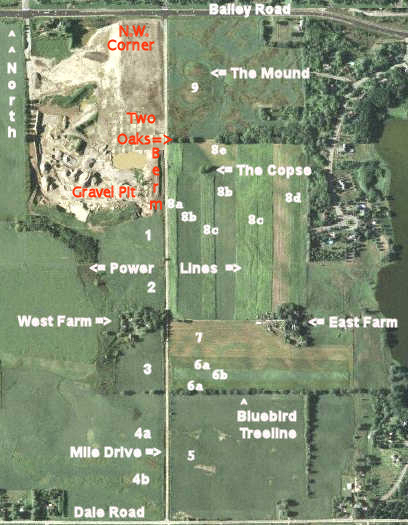
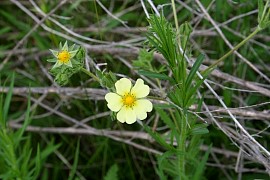 More sulfur cinquefoil (Potentilla recta ) is a Europe and north Asia native introduced into North America
around 1900. It is most often
found growing in the northern U.S. in fields, meadows, pastures, roadsides, and waste places.
More sulfur cinquefoil (Potentilla recta ) is a Europe and north Asia native introduced into North America
around 1900. It is most often
found growing in the northern U.S. in fields, meadows, pastures, roadsides, and waste places.
|
|
|
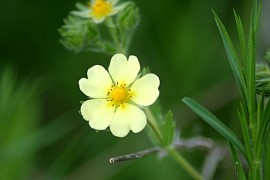 Sulfur cinquefoil has a long life, and is a perennial occurring every year. This weed can have a
life of up to 20-30 years.
Sulfur cinquefoil is a member of the rose family.
Sulfur cinquefoil has a long life, and is a perennial occurring every year. This weed can have a
life of up to 20-30 years.
Sulfur cinquefoil is a member of the rose family.
|
|
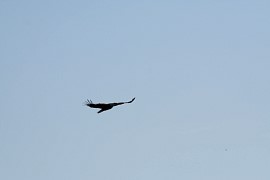
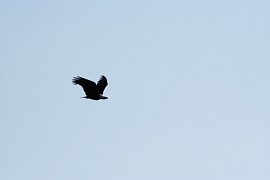
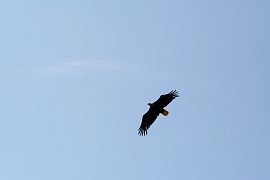
|
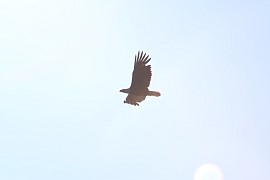
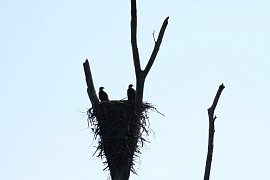
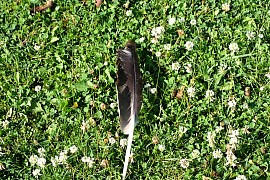
|
|
I left the road and walked over to take some pictures of the eagles. It looks to me that there
are two eaglets. These aren't great pictures, but un-cropped they give a feeling of what it's
like to have the parent eagle wheel about as it checks me out. Eagles are territorial during nesting season. They will keep other eagles out of their own nesting area. Their nesting territory is usually one to two square miles.
The shape of the eagle nest or aerie is determined mainly by the branch point where it's built. Sticks placed in tree forks result in cylindrical or conical shaped nests. Disk shaped nests are built on the ground or a tree branch which is nearly level. Bowl shaped nests occur where the tree trunk branches off into smaller upright branches - like what you see here.
A typical nest is around 5 feet in diameter. Eagles often use the same nest year after year,
which is the case here. Over the years, some nests become enormous, as much as 9 feet in diameter, weighing two tons. Even when a nest tree falls or a strong wind blows a nest down, the established pair usually rebuilds at or near the site within a few weeks if it is near the breeding season. The nest may be built in a tree, on a cliff, or even on the ground if there are no other options available.
At six weeks, the eaglets are very nearly as large as their parents.
At eight weeks, the appetites of the young birds are at their greatest. While parents hunt almost continuous to feed them, back at the nest the eaglets are beginning to stretch their wings in response to gusts of wind and may even be lifted off their feet for short periods.
|
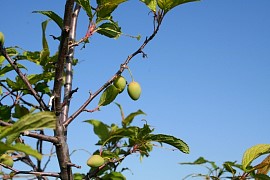
The wild plum trees have grown fruit.
|
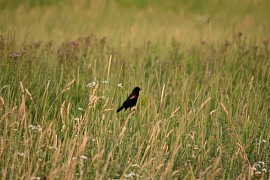
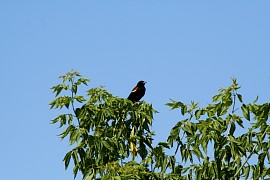
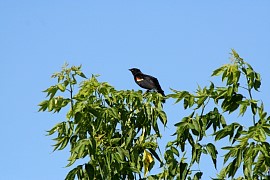 One of the most abundant birds in North America, the Red-winged Blackbird (Agelaius phoeniceus)
is found in wetlands and agricultural areas across the continent. The Red-winged Blackbird is native to North America.
The dull striped female
looks strikingly different than the male and could almost be mistaken for a large dark sparrow.
Return to Birds
One of the most abundant birds in North America, the Red-winged Blackbird (Agelaius phoeniceus)
is found in wetlands and agricultural areas across the continent. The Red-winged Blackbird is native to North America.
The dull striped female
looks strikingly different than the male and could almost be mistaken for a large dark sparrow.
Return to Birds
|
|
The
male bird is easily identified
by it's red and yellow wing patch and also by its loud, frequent, vibrato call.
The male Red-winged Blackbird fiercely defends his territory during the breeding season. He may
spend more than a quarter of all the daylight hours in territory defense. He vigorously keeps all
other males out of the territory and defends the nests from predators. He will attack much larger
animals, including horses and people.
Northern populations migrate south to the southern United States and Central America beginning in
September or October (or occasionally as early as August).
|
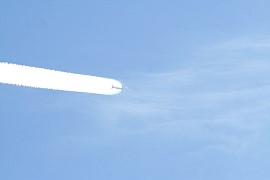
Here is a commercial aircraft creating a wide contrail in the humid air.
|
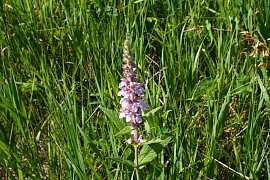
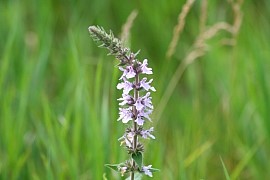
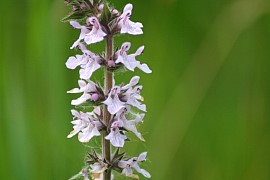 American germander (Teucrium canadense) is a member of the Mint family.
This pretty plant is native to North America. This is in the ditch of Bailey Road - this plant
will get mowed when the county workers come by with a tractor.
Return to Flora
American germander (Teucrium canadense) is a member of the Mint family.
This pretty plant is native to North America. This is in the ditch of Bailey Road - this plant
will get mowed when the county workers come by with a tractor.
Return to Flora
|
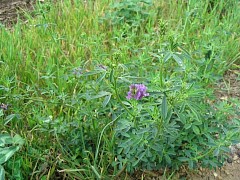
A good picture of alfalfa.
|
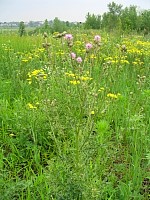
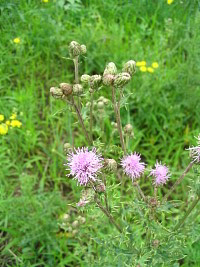
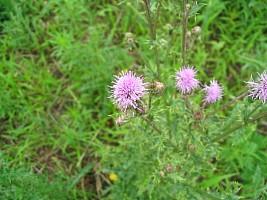 Canada thistle (Cirsium arvense) is an aggressive, creeping perennial weed that infests
crops, pastures, rangeland, roadsides and non crop areas. Generally, infestations start on disturbed
ground, including ditch banks, overgrazed pastures, tilled fields or abandoned sites. Canada thistle
reduces forage consumption in pastures and rangeland because cattle typically will not graze near
infestations. One plant can colonize an area 3 to 6 feet in diameter in one or two years.
Canada thistle is declared a "noxious weed" throughout the U.S. Canada thistle, which is naturalized
from Europe, occurs throughout the northern U.S. east of the Rocky Mountains.
Return to Flora
Canada thistle (Cirsium arvense) is an aggressive, creeping perennial weed that infests
crops, pastures, rangeland, roadsides and non crop areas. Generally, infestations start on disturbed
ground, including ditch banks, overgrazed pastures, tilled fields or abandoned sites. Canada thistle
reduces forage consumption in pastures and rangeland because cattle typically will not graze near
infestations. One plant can colonize an area 3 to 6 feet in diameter in one or two years.
Canada thistle is declared a "noxious weed" throughout the U.S. Canada thistle, which is naturalized
from Europe, occurs throughout the northern U.S. east of the Rocky Mountains.
Return to Flora
|
|
|
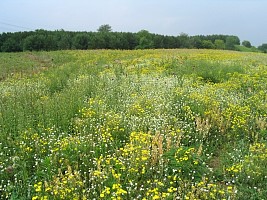
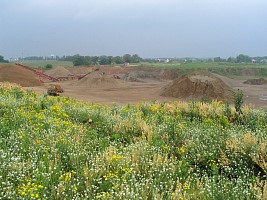
I decided to leave the road and walk along the southern edge of the gravel pit. Enlarge these pictures
to get an idea of the swath of summer color.
|
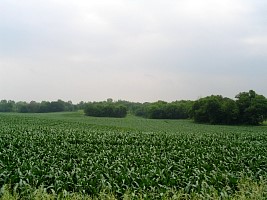
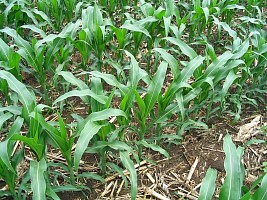
The corn in field #9. So far we have had plenty of rain. That will change.
For 5-6 weeks, the corn plant starts to grow fast. The plant roots grow stronger so that they can hold up the extra weight of the corn as it grows. By the middle of summer, the corn can be taller than the farmer.
|
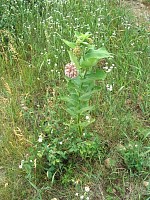
Showy milkweed (Asclepias speciosa).
The name "milkweed" refers to the milky, white sap that is present in most members of this family.
Monarch butterflies lay their eggs on the undersides of showy milkweed and some other
milkweed plants. The larvae consume the foliage, which is toxic, to make themselves and the adult
butterfly stage less palatable to predators. Cattle avoid milkweeds because of the bitter latex
contained in the stems and leaves. Some readers will remember collecting pods (called follicles) of
showy and common milkweed (A. syriaca) during the World War II effort. These pods were filled with
seeds bearing long silky hairs that were used as filler for aviation life jackets.
|
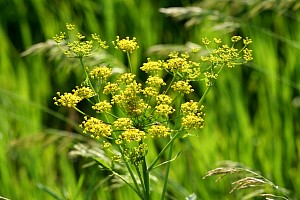
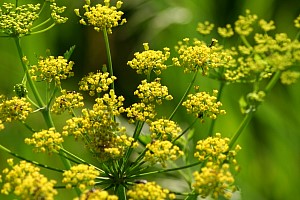
The juices from cuts or breaks of the stem or leaves of Wild Parsnip (Pastinaca sativa)
interact with sunlight to create large painful blisters and discoloration of the skin . It's
native to Europe and Asia. Wild parsnip is a member of the carrot family. It spends its first
summer as a rosette of leaves fairly close to the ground. The plant is anchored in place by a
long, thick taproot. When conditions are right - usually in its second summer it sends up a
single flower stalk that holds hundreds of yellow flowers in flat-topped, umbrella-like
clusters called umbels. The flower stalks can grow to be more than 4-feet tall.
Return to Flora
|